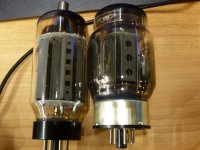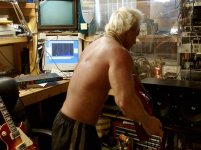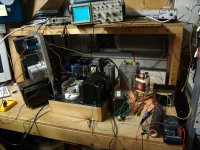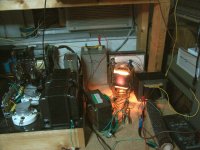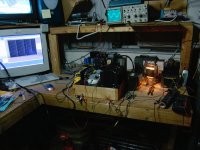The 6GV5's that I stuffed into Pete's Big Red Board will gladly give you 50 watts forever on about 450 volts with a 6.6K ohm load. About 70 watts can be had with a 5K load, and of course more power can be had with more voltage.
Some load lines for comparison:
1) Pete's DCPP - All within spec
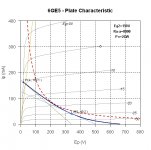
2) Tubelab's guitar amp - let it melt... 😀
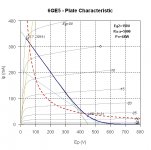
Tubelab's guitar amp - let it melt...
For a reliable amp with the "little sweep tubes" I usually use a 6600 ohm OPT and feed it a bit more B+ as needed, but this is because I still have a bunch of 6600 ohm OPT's....but they do work good at 3300 ohms too.
Why doesn't it melt? There are three factors.
A TV sweep tube doesn't have a volume control. It must run at full power all the time. In the era that many of these tubes were designed, most families had one or maybe two TV sets. It was usually turned on from about 7PM until 11 every day, and all afternoon on Sunday for football plus Saturday morning cartoons. The poor sweep tube doesn't get a break, so they are quite conservatively rated. Compare the plate size in say a good 40 watt audio tube (KT88) to a 40 watt TV sweep tube (6LW6).
The meltdown region of the load line is in the middle of the curve, with the hottest part around half power depending on idle current. If we feed the amp a sine wave at half power and let it run for hours, it WILL melt.
Most listenable music has a peak to average ratio of at least 10 dB, even todays compressed pop music is around 20 db. This means that when you turn that 68 watt amp up to where it starts to distort on peaks, the AVERAGE power output is in the 0.68 watt to 6.8 watt range, and the AVERAGE power burned up in the tube is still in the safe region.
Bass heavy boom - boom music cranked to annoying levels still has some duty cycle associated with it. The bass notes are not on all the time, so for every beat (and it's associated boom) there are longer periods of associated quiet. If the tube sees 30 watts or so for half the time and 10 watts for the other half, the average is still 20 watts.
Now, lets say the dumm blonde guitar player decides to dime the volume knob and hold the guitar up to the speaker for continuous feedback. The amp is now cranking out square waves in the 100+ watt range. Or over 300 W in this picture. The tube dissipates very little power as shown near the top of the curve, so it actually cools off.
Bob Carver bet his career on these principles, and I never blew up my Carver M-400 despite playing my guitar through it (explicitly forbidden in the owners manual).
Attachments
I do not have zero experience.Can you "design" a skyscraper or e.g. a bridge with zero experience? .
The 6GV5's that I stuffed into Pete's Big Red Board will gladly give you 50 watts forever on about 450 volts with a 6.6K ohm load. About 70 watts can be had with a 5K load, and of course more power can be had with more voltage.
Don't want to use Pete's board. I would still study the design, and the one I did for the 6L6GC in AB2 thread. Either could be used for a sweep tube amp build in the 125 WPC and under range.
Posted new P-P power amp design
6L6GC AB2 Amp
Honestly Its sounding more and more like Petes board is already as good as it gets 🙄 I have no obligations against the tubes I have, I'm planning on using them because I got them for 2 bucks each. Its looking like I have a lot more research to do though, as I don't really fully understand how the DCPP amp works, and I think that is key to me building anything good.
What I'm getting from what everyone is saying is that sweep tubes can be run hard, can require lots of drive from the preamp, and this particular tube I have will be happy with around 5k to 6k load impedance.
though it would be nice to get 50Wpc I'm not sure I wan't to spend that much on transformers, and I'm not sure I even need that much power. So I am now thinking about designing for a lower power for cheapness and to fit my listening scenario.
Last edited:
Impressive! It must be turned up to 11.😀The amp is now cranking out square waves in the 100+ watt range. Or over 300 W in this picture. The tube dissipates very little power as shown near the top of the curve, so it actually cools off.
Honestly Its sounding more and more like Petes board is already as good as it gets 🙄 I have no obligations against the tubes I have, I'm planning on using them because I got them for 2 bucks each. Its looking like I have a lot more research to do though, as I don't really fully understand how the DCPP amp works, and I think that is key to me building anything good.
You could just build it from the schem., but the board really makes it easy.
though it would be nice to get 50Wpc I'm not sure I wan't to spend that much on transformers, and I'm not sure I even need that much power. So I am now thinking about designing for a lower power for cheapness and to fit my listening scenario.
The price difference between the Edcor 25W & 50W transformers is less than $10 each.
jeff
This one goes beyond 11!
It was a big experiment that only existed for about a week, back about 10 years ago. Except for pictures, I had a 1/4 inch thick sheet of polycarbonate plastic between me and it. The experiment ran an 833A transmitting tube on 1500 volts in class A SE. It put out about 200 watts of clean sine wave, somewhere near 300 watts of overdriven square wave, and blew the 15 amp bench breaker when I did things like the picture showed.
As you can see it was a short term test that is definitely not safe to be around. There is 1500 volts in that yellow clip lead.
It was a big experiment that only existed for about a week, back about 10 years ago. Except for pictures, I had a 1/4 inch thick sheet of polycarbonate plastic between me and it. The experiment ran an 833A transmitting tube on 1500 volts in class A SE. It put out about 200 watts of clean sine wave, somewhere near 300 watts of overdriven square wave, and blew the 15 amp bench breaker when I did things like the picture showed.
As you can see it was a short term test that is definitely not safe to be around. There is 1500 volts in that yellow clip lead.
Attachments
like Petes board is already as good as it gets
Pete designed it as a conservative amp for about 20 WPC. I modded it up to 250 WPC without major changes, so it is a good stable design. I did a 125 WPC flavor which several people copied.
I built 3 of them. Two were built into chassis and became complete amps, the first one was always an experimental breadboard. They all still work. It would definitely be a good place to start and there are dozens of different tubes that will work in it with no changes.
You could just build it from the schem., but the board really makes it easy.
Makes wiring mistakes far more unlikely.
The price difference between the Edcor 25W & 50W transformers is less than $10 each.
The transformers are the most expensive part of any tube amp and contribute the most to the sound quality. The tubes are far cheaper by comparison, so figure out what transformers you want to use, then choose a circuit design, then figure out the tubes.
There is a mono block PC board for the same design based on my 125WPC mods. I believe that it can only run 6HJ5's though.
Pete designed it as a conservative amp for about 20 WPC. I modded it up to 250 WPC without major changes, so it is a good stable design. I did a 125 WPC flavor which several people copied.
The transformers are the most expensive part of any tube amp and contribute the most to the sound quality. The tubes are far cheaper by comparison, so figure out what transformers you want to use, then choose a circuit design, then figure out the tubes.
I've actually put some thought into using these. Reflected impedance should be 3.2k with an 8 ohm load. They have 2 115V windings that I can series to use for PP. but All I know is that the impedance is right, I have no way of knowing how much current they can handle or how they will sound. But for 20 bucks each and not having to wait 6 weeks I might just try it.
Last edited:
The max voltage rating of xfmrs gets derated linearly with frequency below the design freq. (usually 50/60 Hz) due to core saturation. So that 115V primary will probably only handle 38 Volts AC at 20 Hz.
------
George got those little 6GF5 tubes putting out 70 Watts!! 😱
Must be tough little tubes. Maybe George is vacationing in Siberia or the Yukon.
I recently noticed in AudioXPress, August 2004, page 16, the article on Norman Crowhurst's "Twin Coupled" amplifier as adapted by John Stewart. He mentions that Sweep tubes can typically handle 40% more Pdiss for audio than their ratings. I usually figure about 30% more for conservative rating. So the 16GV5 would then look like a 23 to 24.5 Watt audio tube equivalent by that adjustment.
------
George got those little 6GF5 tubes putting out 70 Watts!! 😱
Must be tough little tubes. Maybe George is vacationing in Siberia or the Yukon.
I recently noticed in AudioXPress, August 2004, page 16, the article on Norman Crowhurst's "Twin Coupled" amplifier as adapted by John Stewart. He mentions that Sweep tubes can typically handle 40% more Pdiss for audio than their ratings. I usually figure about 30% more for conservative rating. So the 16GV5 would then look like a 23 to 24.5 Watt audio tube equivalent by that adjustment.
Last edited:
The max voltage rating of xfmrs gets derated linearly with frequency below the design freq. (usually 50/60 Hz) due to core saturation. So that 115V primary will probably only handle 38 Volts AC at 20 Hz.
What is the risk I run by using this transformer? You say it will only handle ~38VAC at 20hz, but are we talking like a transformer on fire? Or bad frequency response?
What is the risk I run by using this transformer? You say it will only handle ~38VAC at 20hz, but are we talking like a transformer on fire? Or bad frequency response?
Generally it should not be a problem because there isn't much of 20-30 Hz in most music, and 38 W is a lot of power to handle those frequencies. If such very low frequencies exceed the 38 W level, it will cause severe harmonic distortion and intermodulation.
For the g2 voltage, George has a proper load line( excluding dissipation limits perhaps ). For the 1) loadline, you'll get better performance and nearly as much power if you reduce g2 voltage so the g1=0V line occupies territory previously run by the -10V g1 line.
cheers,
Douglas
cheers,
Douglas
"You say it will only handle ~38VAC at 20hz, but are we talking like a transformer on fire? Or bad frequency response?"
Just bad frequency response. No fire with a typical audio signal.
Some reasonable Edcor OTs, but some waiting time for these:
$30, 10 Watt EDCOR - GXPP10-5K
$41, 15 Watt EDCOR - GXPP15-5K
$54, 25 Watt EDCOR - CXPP25-5K
$72, 60 Watt EDCOR - CXPP60-4.2K
A 60 Watt OT would also work with Pete Millett's latest 50 Watt amplifier. (the PC board version only readily fitting the 6HJ5 tube pin-out, looks like one socket pin change to fit 6/21HB5 or 6/12GE5)
Just bad frequency response. No fire with a typical audio signal.
Some reasonable Edcor OTs, but some waiting time for these:
$30, 10 Watt EDCOR - GXPP10-5K
$41, 15 Watt EDCOR - GXPP15-5K
$54, 25 Watt EDCOR - CXPP25-5K
$72, 60 Watt EDCOR - CXPP60-4.2K
A 60 Watt OT would also work with Pete Millett's latest 50 Watt amplifier. (the PC board version only readily fitting the 6HJ5 tube pin-out, looks like one socket pin change to fit 6/21HB5 or 6/12GE5)
Last edited:
George got those little 6GF5 tubes putting out 70 Watts!!
I didn't say how long they lasted......I just turned the knob up to see how far they would go. They probably wouldn't live long if run continuously at that level, but would probably do OK playing music with occasional peaks to 70 W.
"You say it will only handle ~38VAC at 20hz, but are we talking like a transformer on fire? Or bad frequency response?"
No you won't set the OPT on fire, but repeated trips into saturation might make your output tubes mad (red faced kinda mad).
I used an Antek power toroid as an OPT in a guitar amp back in the Hundred Buck Amp Challenge. The idea was to build a guitar amp for minimum $$$, but no more than $100 total parts cost.
I made a real cheap amp, less than $50. It used $4 worth of tubes and a $5 line matching transformer for the OPT. It made 4 watts, screamed real good and I still play it.
I made a second amp that cost about $99.99 to see what I could do for $100. It used an Antek toroid for the OPT. I think it was a 50VA unit, but I'm not totally sure. It was a 9 volt unit since I needed about 3 K ohms. The amp made 20 watts of clean power, but the lowest note on a guitar is 82Hz. The OPT was not the limiting factor, the tubes and the B+ voltage were.
Last edited:
George,
What OT primary impedances did you try the 6JN6 tubes with, using Pete's red board. Just 6.6K, or 3.3K too?
What OT primary impedances did you try the 6JN6 tubes with, using Pete's red board. Just 6.6K, or 3.3K too?
Since these experiments took place about 8 years ago, I don't remember all the details like which tube got tested how. Searching through the original thread, I found your answer. From post#153:
Those little tubes have a peak cathode current rating of 550 mA. Stuffing 450 volts into 825 ohms asks them for 667 mA. Tubes lose efficiency and their voltage drop goes up when asked for too much current.
I have no idea what condition the tubes were in back then, but I did find a statement in the thread where I had 10 of them, so I probably picked 2 good ones.
I have used these transformers in several other circuits as 3.3K ohm transformers by connecting the 8 ohm laod to the 16 ohm tap. That produced a loss of power (only a few watts) and an increase in distortion with the 6JN6's. I did not attempt to find out why, or even try it at a different idle current.
Those little tubes have a peak cathode current rating of 550 mA. Stuffing 450 volts into 825 ohms asks them for 667 mA. Tubes lose efficiency and their voltage drop goes up when asked for too much current.
I have no idea what condition the tubes were in back then, but I did find a statement in the thread where I had 10 of them, so I probably picked 2 good ones.
Thanks for the info George.
The reason I asked, is from making a comparison with the 6L6GC datasheet info.
The 6JN6 (or 17GV5) has a DC max current rating of 175 mA, while the 6L6GC (7027) has a max DC current rating of 110 mA. This is like having more tube in parallel. So a sort of apples to apples comparison in class AB1 would have the 6JN6 using a 110/175 x 6600 = 4150 Ohm OT, versus 6600 Ohm for the 6L6 (per datasheet). (with reduced B+ and reduced Vg2 to stay within the 17.5 Watt 6JN6 Pdiss)
So the 6.6K or 8K (DCPP) OTs being used in recent amplifiers give the 6JN6 (17GV5) some sneaky advantage in the distortion department. (less of the gm curve being traversed).
An 8K OT for the 6JN6 would correspond to a 6L6GC running with a 12700 Ohm OT! On the other hand, a 6L6GC running with a 3800 Ohm OT (another 6L6 datasheet spec) would correspond to a 6JN6 using a 2400 Ohm OT.
One can do this (higher Z OT thing) as long as the individual plate curves do not have much curvature in them from screen current distortion. 6JN6 and relatives have fairly straight plate curves. So this is likely some of the explanation for these TV Sweep tube amps sounding "unreasonably" good. (as some long time "audio" tube users have quietly mentioned )
The reason I asked, is from making a comparison with the 6L6GC datasheet info.
The 6JN6 (or 17GV5) has a DC max current rating of 175 mA, while the 6L6GC (7027) has a max DC current rating of 110 mA. This is like having more tube in parallel. So a sort of apples to apples comparison in class AB1 would have the 6JN6 using a 110/175 x 6600 = 4150 Ohm OT, versus 6600 Ohm for the 6L6 (per datasheet). (with reduced B+ and reduced Vg2 to stay within the 17.5 Watt 6JN6 Pdiss)
So the 6.6K or 8K (DCPP) OTs being used in recent amplifiers give the 6JN6 (17GV5) some sneaky advantage in the distortion department. (less of the gm curve being traversed).
An 8K OT for the 6JN6 would correspond to a 6L6GC running with a 12700 Ohm OT! On the other hand, a 6L6GC running with a 3800 Ohm OT (another 6L6 datasheet spec) would correspond to a 6JN6 using a 2400 Ohm OT.
One can do this (higher Z OT thing) as long as the individual plate curves do not have much curvature in them from screen current distortion. 6JN6 and relatives have fairly straight plate curves. So this is likely some of the explanation for these TV Sweep tube amps sounding "unreasonably" good. (as some long time "audio" tube users have quietly mentioned )
Last edited:
Running the tube out beyond spec current/Watts of course straightens out the gm curve further besides. Then, combined with the higher equivalent OT Z primary (so less gm curve traversed) should produce amazing results.
Some practitioners are known to use this "technique". 🙂
(low cost tubes are helpful here)
Some practitioners are known to use this "technique". 🙂
(low cost tubes are helpful here)
Last edited:
The 6JN6 (or 17GV5) has a DC max current rating of 175 mA, while the 6L6GC (7027) has a max DC current rating of 110 mA
The common audio tubes rarely have published PEAK plate current specs (550 mA on 6GV5). This is usually the point where the available space charge begins to be depleted, thus changing the tube's characteristics. The point of cathode damage isn't too far above this.
Tube arcs usually require far more current, depending on how well the tube was made. A perfect tube with all the elements perfectly collinear will sustain lost of current because it's evenly distributed, and all of the plate will turn red at the same time. A poorly made tube will have one point of highest current density and a corresponding hot spot on the plate. The data sheets are compromises between blown tubes (warrantee claims) and specmanship (my tube is bigger than your tube).
One look at the size of the cathode in a 6L6GC and that of ANY true sweep tube (including the tiny 6GF5) and it becomes obvious why sweep tubes excel in the dynamics and overload department......there are far more "available electrons" to play with.
Note that some of the early sweep tubes were derivatives of other common tubes, and don't really have sweep tube characteristics. The max screen voltage spec is the clue. The 6BG6 IS a 6L6GA with a top cap and different pinout to allow for high voltage on the plate without the dreaded fireworks from a pin 3 to pin 2 arc seen with the common audio tubes in cranked guitar amps. There is another tiny octal "sweep tube" with 6L6 guts and no plate cap. Same pinout as the 6AV5. I don't remember the number but it might be the 6BD5.
The first real sweep tube that I remember playing with as a kid in the 60's was the 6BQ6. These were the most common "big tube" found in the trash dump in discarded 50's TV sets. The 6DQ6 was less common and I could never tame them as a 12 year old guitar amp builder.....of course I didn't understand things like "bias" and "impedance" at the time.
- Status
- Not open for further replies.
- Home
- Amplifiers
- Tubes / Valves
- 17GV5 - push pull
